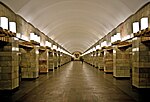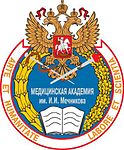Devyatkino (Saint Petersburg Metro)

Devyatkino (Russian: Девя́ткино; until 1992 Komsomolskaya Russian: Комсомольская) is a station of the Saint Petersburg Metro and St. Petersburg–Kuznechnoye railway. It is the only Metro station located outside the city limits, in Vsevolozhsky District of Leningrad Oblast. It is the northern terminus of the Kirovsko–Vyborgskaya Line. The name of the station is derived from the name of nearby suburb. Like Rybatskoye, Kupchino and Parnas the station is located on the surface and connected to an electrichka commuter train station by the same name. In this case, the southbound train tracks are on the left side of the station while the northbound tracks are on the right, allowing for easy transfers between the subway and the trains. Devyatkino was opened on 29 December 1978 as the part of the last segment of the line. Until 1982 it was the northernmost metro station in the world, which was surpassed by the Helsinki Metro.
Excerpt from the Wikipedia article Devyatkino (Saint Petersburg Metro) (License: CC BY-SA 3.0, Authors, Images).Devyatkino (Saint Petersburg Metro)
Привокзальная площадь, Муринское городское поселение
Geographical coordinates (GPS) Address Nearby Places Show on map
Geographical coordinates (GPS)
| Latitude | Longitude |
|---|---|
| N 60.050256 ° | E 30.442219 ° |
Address
Привокзальная площадь 6
188662 Муринское городское поселение, Западное Мурино
Leningrad oblast, Russia
Open on Google Maps











